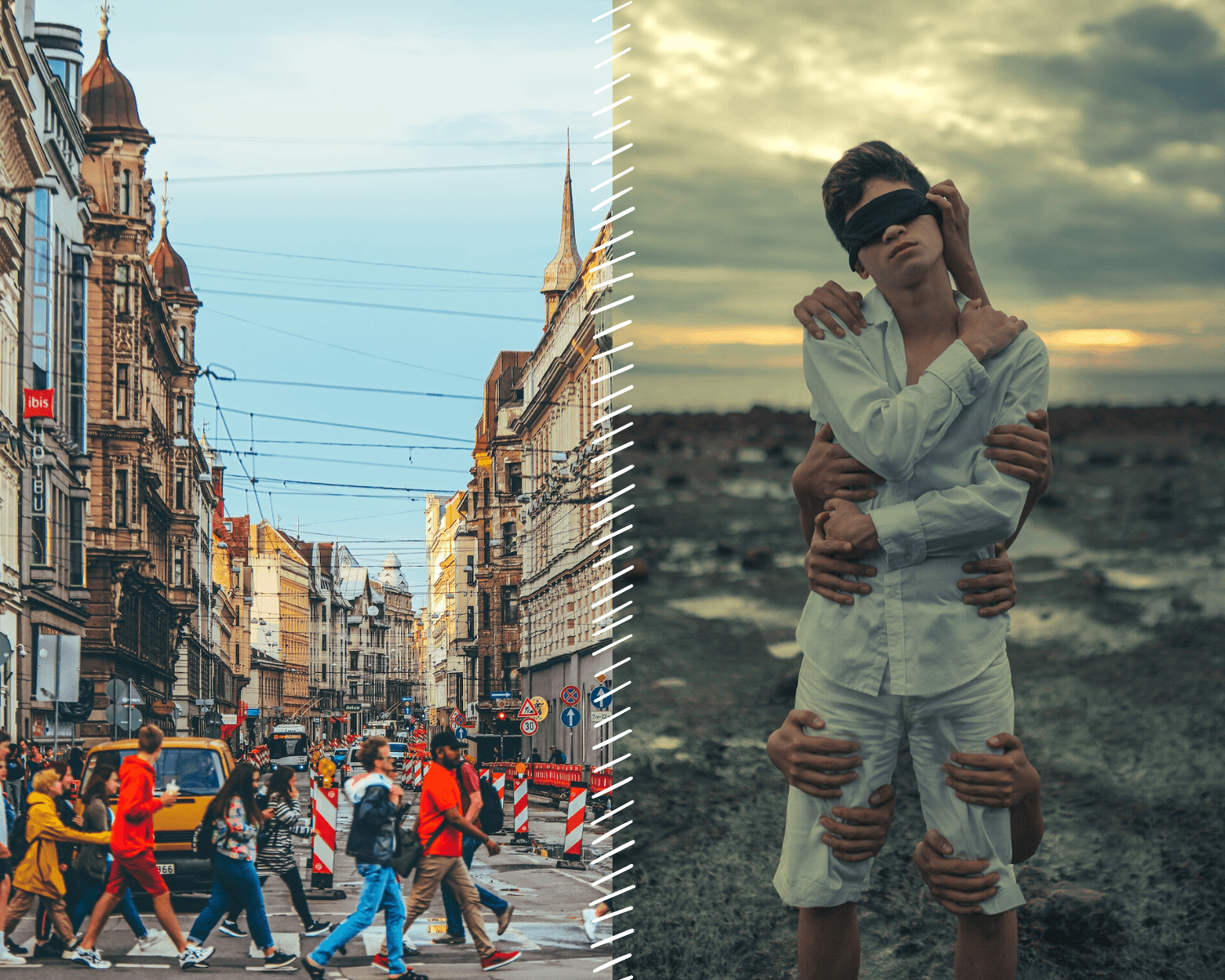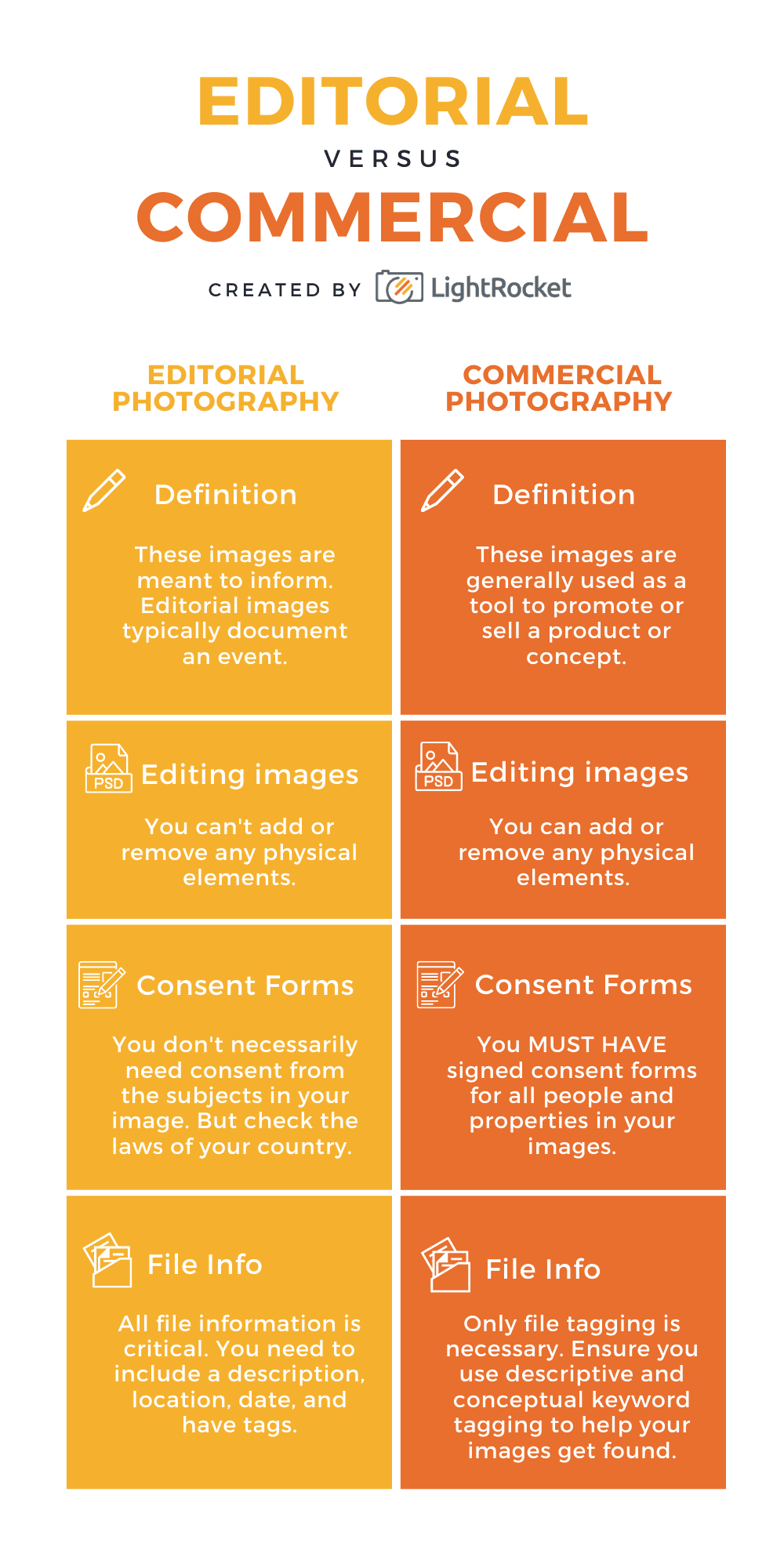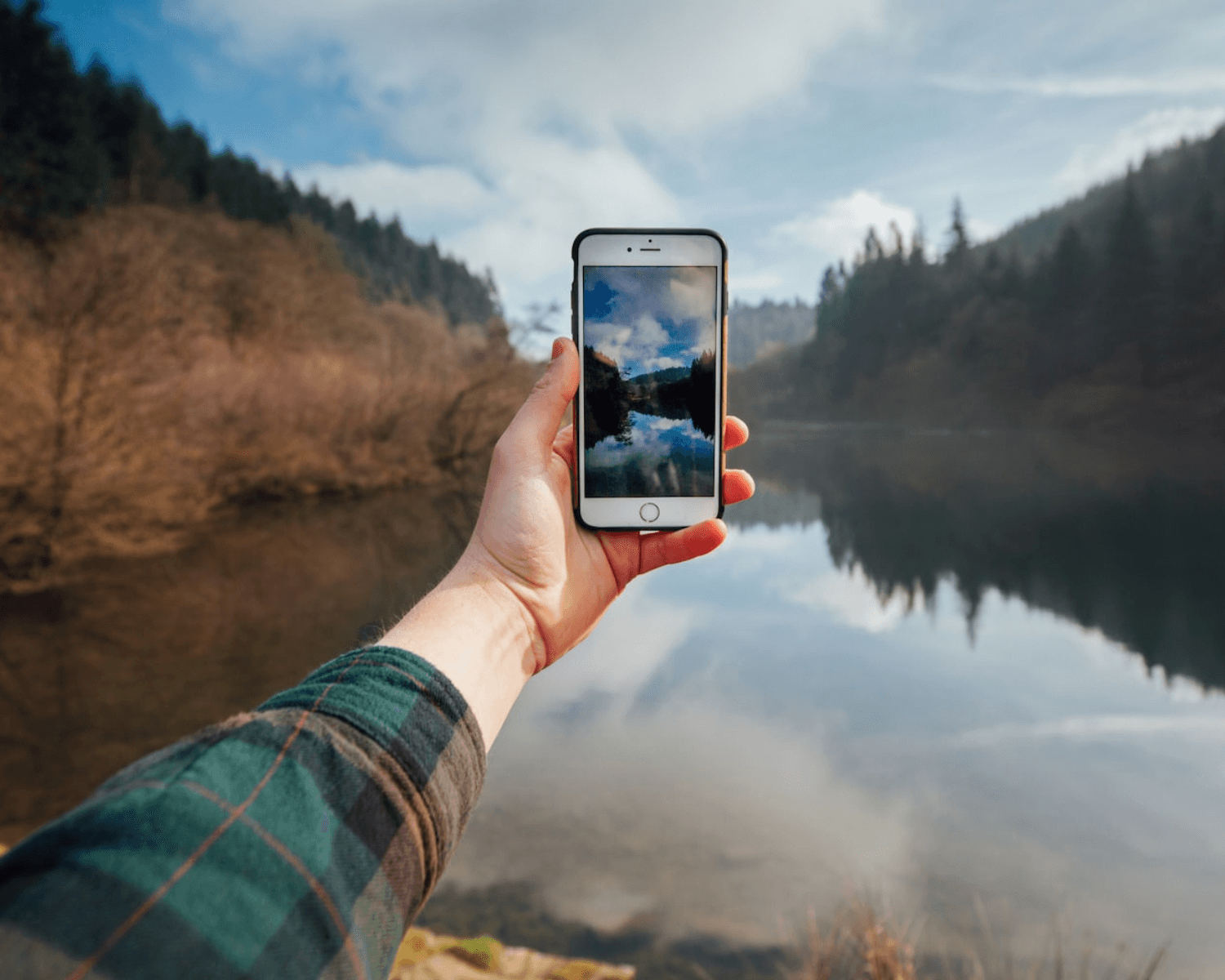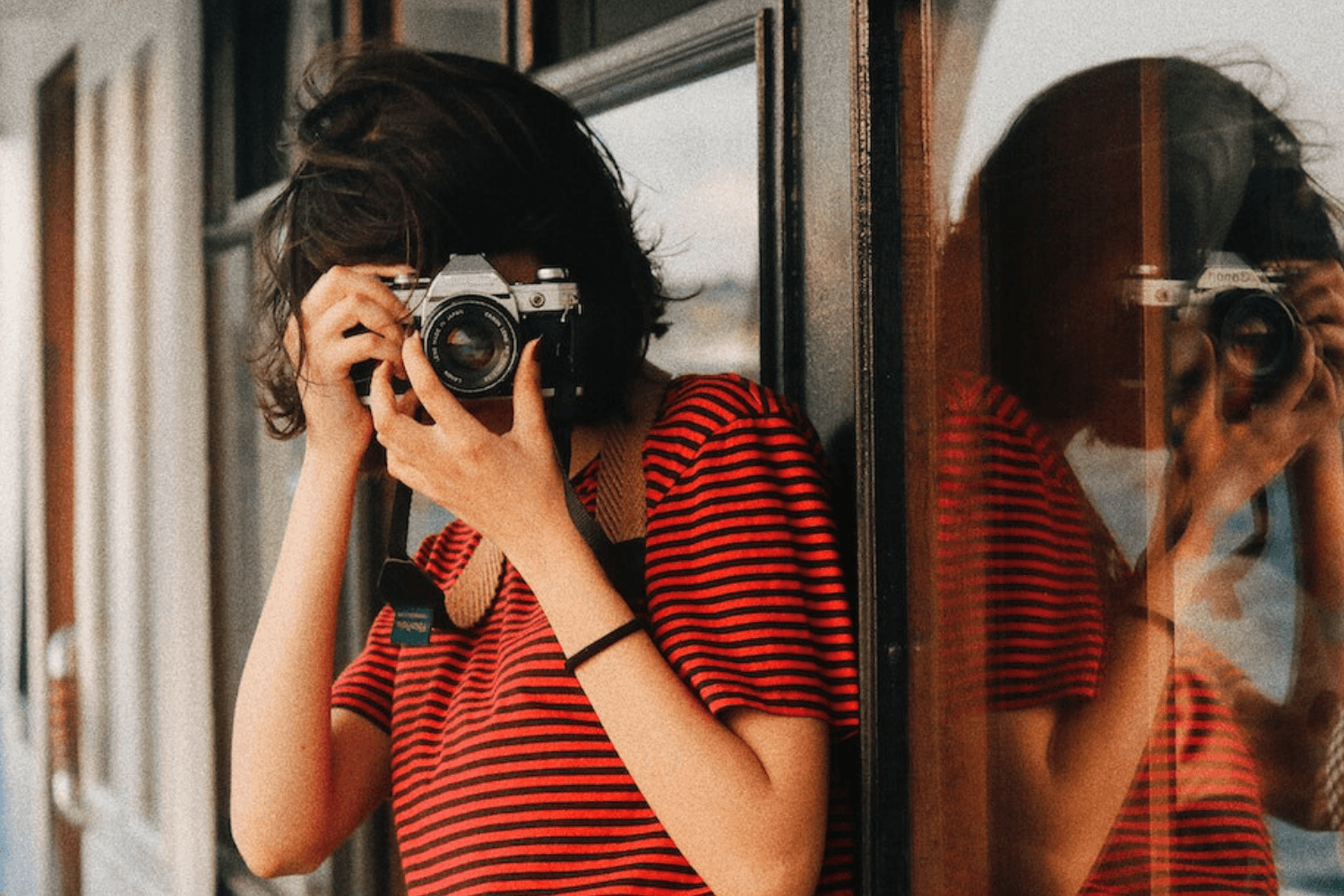Editorial and Commercial Photography: What's the difference?
Yvan Cohen
Wed Sep 14 2022

By Yvan Cohen
The difference between editorial and commercial photography is similar to the difference between photojournalism and advertising. Photojournalism and editorial photography use photography to communicate information with no commercial angle. Whereas, advertising and commercial photography use photography as a tool to promote or sell a product or concept.
Here’s a quick overview of the topics discussed throughout the blog. Read on for details.
 Infographic showing the key differences between editorial and commercial photography.
Infographic showing the key differences between editorial and commercial photography.
Editorial photography
Editorial photography is bound by a code of ethics which are designed to ensure that these photographs serve as a reliable representation of reality. In the pre-digital era it was often said that ‘the camera never lies’. Today’s digital editing tools mean that may not always be true.
 A group of Emperor penguins (Aptenodytes forsteri) with chicks on the fast ice at the Emperor penguin colony at Snow Hill Island in the Weddell Sea in Antarctica. Photo and story credits by Wolfgang Kaehler
A group of Emperor penguins (Aptenodytes forsteri) with chicks on the fast ice at the Emperor penguin colony at Snow Hill Island in the Weddell Sea in Antarctica. Photo and story credits by Wolfgang Kaehler
How technology has changed editorial photography
In the era before digital photography, images were recorded to celluloid film, and photographs were difficult to manipulate. As cameras became portable, photographers were able to take pictures in almost any situation. This lead to the birth of photojournalism.
For this new generation, photography emerged as a powerful tool through which the realities of our world could be captured and shared in print. For the first time, photographers were direct witnesses to the horrific truths of war and poverty. Editorial photography flourished on the pages of magazines like Time-Life and in daily newspapers. You can read more about how these technological advancements helped shape our perspective of war through the photographs taken on the battlefield.
In the digital era, images have become infinitely malleable. This has all but evaporated the idea that the camera never lies. As the ability to take pictures has become easy and universally accessible, the very concept of photojournalism as an organized profession is also becoming diluted.
Don’t add or remove elements in editorial photography
Where once editorial photography was confined to a small group of professionals, today everybody is photographing everything all the time. It can be tricky to tell which images show the truth among the tidal wave of images surging onto our screens.
This is why the unwritten ethics of professional editorial photography are more vital today than ever before. The most important rule of all is don’t add or remove anything from your picture! If you wish to present your work as ‘editorial’, you must not add or remove any physical elements in your pictures as tempting (and easy) as that may be.
The only ethically acceptable manipulation includes cropping, changes to tone, exposure and contrast (or the many other subtle changes you can make using software like Photoshop, without adding or removing elements). The principal is simple: an editorial image is intended to inform – as reliably and as truthfully as possible.
 Photo by Jonathan Borba
Photo by Jonathan Borba
Editorial photographs need file information
Editorial photographs also need context. An editorial image without basic file information could easily be misinterpreted or be misleading. And you don’t want that.
If you want to upload and license your work as editorial, you’ll need to add some key data or file information. This includes a description of the picture (the who, what and why of your picture), the location, and some tags (so your work can be easily found in a search).
At LightRocket we don’t consider an editorial photograph to be valid for licensing unless there is at least a comprehensive description, location info (at least a country), and a date taken. You should also make sure you have a credit and copyright notice too.
What about model releases and permission?
The general rule with editorial photography is that you don’t need a formal consent form for subjects captured in a public place. The idea is that you are photographing life as it is, which means you don’t want to disturb the authenticity of a scene by intervening to ask for formal permission or a signed consent form.
This being said, there are varying cultural and legal norms in different countries, meaning you may need to ask permission before taking a picture depending where you are. You should also avoid taking shots of people in a private setting, as this violates their right to privacy.
In some nations, like France and Germany, there are legal restrictions on taking somebody’s picture and disseminating it without their permission. For useful tips to help you better understand permission in photography, click here.
You’ll need to be aware of cultural sensitivities too, and always work with a sense of respect and empathy for your subjects. Especially when covering people in situations of distress or hardship. Even if you respect the basic rules of editorial photography, an image of suffering without understanding or empathy can quickly become exploitative. You can also read more about asking for permission here.
Commercial Photography
Commercial photography is sometimes referred to as creative photography (you’ll see it referred to as creative photography on Getty’s website for example).
 Image of two well dressed business people in Detroit, USA. Photo credits by Rebrand Cities
Image of two well dressed business people in Detroit, USA. Photo credits by Rebrand Cities
Unlike editorial photography, you can manipulate commercial images to your heart’s content. This includes adding and removing elements and changing whatever you like. You can be as creative as you like – if it serves the aesthetic, conceptual, and promotional purpose of your image.
You need signed releases and consent for commercial photography
One of the most important differences between editorial and commercial photography is the need for signed permissions. This applies to both properties and people. If you intend to depict a recogniseable person in a photograph, later to be made available for commercial use, you must get signed permission.
To do this you’ll need get your subject to sign a document known as a ‘model release’. This should at least include the name and contact details of your subject (and sometimes a picture of them too). Details of the extent of usage. date, and location, should also be included.
Here’s a sample model release form, although there are quite a few different documents online.
Rules relating to property releases can vary from country to country. Therefore, if you’ve created a commercial image with no recogniseable people in it, you may still need signed permission for any buildings or interiors in your photograph. Particularly if you intend to exhibit or sell your images.
 Photo by Alex Green
Photo by Alex Green
Tagging your commercial photographs
Though it can’t hurt to add it, you generally don’t need to worry about adding a descriptive caption or even a location for creative imagery. The context of a commercial/creative photograph is usually not important.
However, the conceptual meaning of a commercial image is essential. If you’re creating commercial imagery for stock, the salability of your photograph will largely depend on your tags. How else will people find your images?
How many tags do I add?
It’s tempting to go crazy when tagging your pictures, on the basis that the more tags you add, the more likely your picture is to be found. But this isn’t necessarily true. Excessive tags produce inaccurate results for clients searching on a site. Also, adding excessive tags will only take more of your time and won’t increase your chance of making a sale.
Less is more where tags are concerned. While there are systems that offer AI tagging of images, these are limited to recognizing the physical elements of an image, objects, colour and perhaps even expressions. AI tagging won’t be able to identify and list the core concept of an image. And where commercial imagery is concerned, it’s these concepts that matter.
Conceptual tagging matters
Most commercial images available online are created to express an idea or concept which can be used to support a promotional campaign.
For example, an image of hands clasped together might suggest ‘trust’, ‘unity’, ‘togetherness’ or ‘friendship’, and so on. These are the kinds of conceptual tags you should be adding to your commercial images. Imagine an insurance company looking for an image to convey ‘trust’ or ‘security’. Their search is going to be driven by concepts. This doesn’t mean you shouldn’t include key elements like ‘hand’ or ‘holding’. These will also help a client find exactly the image they are looking for.
One way to measure the quality of your tags is to imagine somebody searching the tags you have used and seeing your picture. How would they feel? If you think they’d be happy with the result, then you’re almost certainly adding the right tags. If not, you’ll need to keep at it until you get your desired result.
Written by Yvan Cohen | Yvan has been a photojournalist for over 30 years. He’s a co-founder of LightRocket and continues to shoot photo and video projects around South East Asia.
To read more helpful articles on photography, check out our blog page.
Join our growing photographer community at LightRocket and get powerful archive management and website building tools for free!


